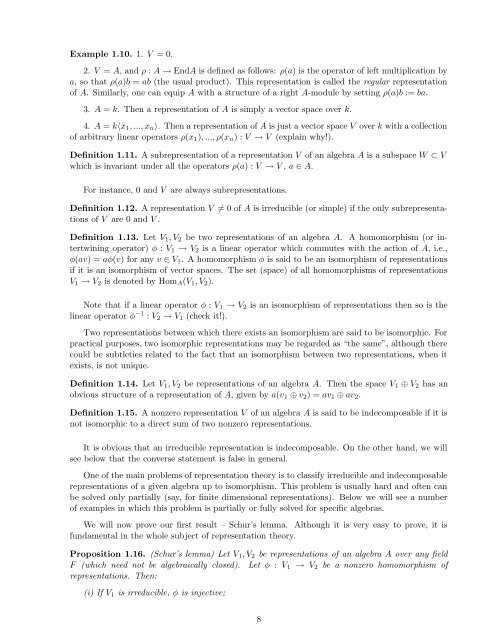Lecture notes for Introduction to Representation Theory
Lecture notes for Introduction to Representation Theory
Lecture notes for Introduction to Representation Theory
Create successful ePaper yourself
Turn your PDF publications into a flip-book with our unique Google optimized e-Paper software.
Example 1.10. 1. V = 0.<br />
2. V = A, and δ : A ⊃ EndA is defined as follows: δ(a) is the opera<strong>to</strong>r of left multiplication by<br />
a, so that δ(a)b = ab (the usual product). This representation is called the regular representation<br />
of A. Similarly, one can equip A with a structure of a right A-module by setting δ(a)b := ba.<br />
3. A = k. Then a representation of A is simply a vec<strong>to</strong>r space over k.<br />
4. A = k◦x 1 , ..., x n . Then a representation of A is just a vec<strong>to</strong>r space V over k with a collection<br />
of arbitrary linear opera<strong>to</strong>rs δ(x 1 ), ..., δ(x n ) : V ⊃ V (explain why!).<br />
Definition 1.11. A subrepresentation of a representation V of an algebra A is a subspace W →<br />
which is invariant under all the opera<strong>to</strong>rs δ(a) : V ⊃ V , a A.<br />
For instance, 0 and V are always subrepresentations.<br />
Definition 1.12. A representation V ⇒= 0 of A is irreducible (or simple) if the only subrepresentations<br />
of V are 0 and V .<br />
Definition 1.13. Let V 1 , V 2 be two representations of an algebra A. A homomorphism (or intertwining<br />
opera<strong>to</strong>r) θ : V 1 ⊃ V 2 is a linear opera<strong>to</strong>r which commutes with the action of A, i.e.,<br />
θ(av) = aθ(v) <strong>for</strong> any v V 1 . A homomorphism θ is said <strong>to</strong> be an isomorphism of representations<br />
if it is an isomorphism of vec<strong>to</strong>r spaces. The set (space) of all homomorphisms of representations<br />
V 1 ⊃ V 2 is denoted by Hom A (V 1 , V 2 ).<br />
Note that if a linear opera<strong>to</strong>r θ : V 1 ⊃ V 2 is an isomorphism of representations then so is the<br />
linear opera<strong>to</strong>r θ −1 : V 2 ⊃ V 1 (check it!).<br />
Two representations between which there exists an isomorphism are said <strong>to</strong> be isomorphic. For<br />
practical purposes, two isomorphic representations may be regarded as “the same”, although there<br />
could be subtleties related <strong>to</strong> the fact that an isomorphism between two representations, when it<br />
exists, is not unique.<br />
Definition 1.14. Let V 1 , V 2 be representations of an algebra A. Then the space V 1 V 2 has an<br />
obvious structure of a representation of A, given by a(v 1 v 2 ) = av 1 av 2 .<br />
Definition 1.15. A nonzero representation V of an algebra A is said <strong>to</strong> be indecomposable if it is<br />
not isomorphic <strong>to</strong> a direct sum of two nonzero representations.<br />
It is obvious that an irreducible representation is indecomposable. On the other hand, we will<br />
see below that the converse statement is false in general.<br />
One of the main problems of representation theory is <strong>to</strong> classify irreducible and indecomposable<br />
representations of a given algebra up <strong>to</strong> isomorphism. This problem is usually hard and often can<br />
be solved only partially (say, <strong>for</strong> finite dimensional representations). Below we will see a number<br />
of examples in which this problem is partially or fully solved <strong>for</strong> specific algebras.<br />
We will now prove our first result – Schur’s lemma. Although it is very easy <strong>to</strong> prove, it is<br />
fundamental in the whole subject of representation theory.<br />
Proposition 1.16. (Schur’s lemma) Let V 1 , V 2 be representations of an algebra A over any field<br />
F (which need not be algebraically closed). Let θ : V 1 ⊃ V 2 be a nonzero homomorphism of<br />
representations. Then:<br />
(i) If V 1 is irreducible, θ is injective;<br />
V<br />
8

















